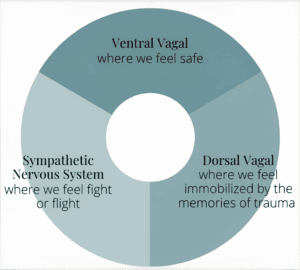The Hidden Language of Your Nervous System
This article has been researched and written by Moni El Ramlawy. AI has not been used in producing this article.
Before you say, “I’m fine,” your nervous system has already responded. That response doesn’t come from logic, reasoning, or even conscious thought – it comes from your body’s survival system. Polyvagal Theory, developed by Dr. Stephen Porges, offers a powerful lens to understand how our nervous systems respond to our emotional triggers. It tells us that we’re not just reacting to the world through our thoughts – we’re constantly scanning for cues of safety and danger. According to this theory, our nervous system navigates three main states to manage stress. When we understand them, we begin to decode the hidden language our body speaks every day.

1. Safety & Connection (Ventral Vagal State)
This is your state of presence and regulation. When you’re in ventral vagal, your body feels safe and calm. This is your “I’m okay, I’m connected, I can think clearly” state. In this state, you can experience joy, healing, intimacy, and connection. You can express emotions, problem-solve, and reflect.
2. Alert (Sympathetic State)
This is a state of threat, and when your nervous system detects threat (real or perceived), it shifts into action. This is what we call the fight-or-flight response. You might feel agitated or anxious. Your heart races, muscles tense, and everything feels urgent. This is not a weakness; it’s your body trying to protect you, and while this state is essential for survival, being stuck there for too long can lead to burnout or chronic stress.
3. Shutdown (Dorsal Vagal State)
This state is like an emergency brake. When the threat feels overwhelming and escape seems impossible, the body goes into a state of freeze. You may feel spacey, numb, or exhausted. It can look like depression, but it’s actually a survival response when fight-or-flight no longer works.
Learning to notice these states helps you recognize your emotions. When you begin to understand how your nervous system works, you gain the power to regulate – through breath, movement, connection, and support – and you become more attuned to what you need: a pause, a boundary, a hug.
Managing Depression During Social Isolation
The outbreak of the global coronavirus pandemic is stressful for many people. Since the World Health Organization (WHO) declared the COVID-19 outbreak a global pandemic, regions across the world have mandated quaran…
What are Cognitive Behavioral Therapists?
Cognitive behavioral therapy (CBT) is a common type of talk therapy (psychotherapy) that has been demonstrated effective for a range of mental health struggles including anxiety disorders, depression, substance abuse …
Managing COVID-19 – Related Anxiety
The recent increase of COVID-19 cases in Europe and in the rest of the world has seen a great increase of strong emotions, such as overwhelming fear and worry, in our community. Despite the fact that the infection has…
What to Expect at Your First Family Therapy Session
Are you feeling a bit nervous about your first family therapy session? It’s very common to feel a bit apprehensive before starting any type of therapy. Therapy involves sharing personal information and intimate detail…
What do you really know about ADHD?
ADHD, or attention deficit disorder, is a commonly known mental health disorder and can be easily described by teasing apart its acronym. Most of us have been made aware of the condition through social media, advertis…
Taking Your First Steps to Seeing a Therapist
More often than not, the first step people take towards overcoming their mental illnesses, is making the decision to talk to someone about it, whether it’s a friend or a professional. It doesn’t help that our cultural…
The Benefits of Family Therapy
Family plays an essential role in our emotional, spiritual, and intellectual lives. Over the past few decades, the nuclear family has evolved and changed. Despite these changes to what a particular family unit include…
- « Previous
- 1
- …
- 4
- 5
- 6








